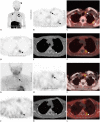Performance of F-18 Fluorocholine PET/CT for Detection of Hyperfunctioning Parathyroid Tissue in Patients with Elevated Parathyroid Hormone Levels and Negative or Discrepant Results in conventional Imaging
- PMID: 31997599
- PMCID: PMC6992441
- DOI: 10.3348/kjr.2019.0268
Performance of F-18 Fluorocholine PET/CT for Detection of Hyperfunctioning Parathyroid Tissue in Patients with Elevated Parathyroid Hormone Levels and Negative or Discrepant Results in conventional Imaging
Abstract
Objective: Our aim was to assess the diagnostic performance of F-18 fluorocholine (FCH) positron emission tomography/computed tomography (PET/CT) in detecting hyperfunctioning parathyroid tissue (HPT) in patients with elevated parathyroid hormone levels with negative or inconclusive conventional imaging results and to compare the findings with those obtained using technetium-99m sestamibi (MIBI) scintigraphy and neck ultrasonography (US).
Materials and methods: Images of 105 patients with hyperparathyroidism who underwent FCH PET/CT, dual-phase MIBI parathyroid scintigraphy (median interval: 42 days), and neck US were retrospectively analyzed. The gold standard was histopathological findings for 81 patients who underwent parathyroidectomy and clinical follow-up findings in the remaining 24 patients. Sensitivities, positive predictive values (PPVs), and accuracies were calculated for all imaging modalities.
Results: Among the 81 patients who underwent parathyroidectomy, either parathyroid adenoma (n = 64), hyperplasia (n = 9), neoplasia (n = 4), or both parathyroid adenoma and hyperplasia (n = 1) were detected, except 3 patients who did not show HPT. Of the 24 (23%) patients who were followed-up without operation, 22 (92%) showed persistent hyperparathyroidism. FCH PET/CT showed significantly higher sensitivity than MIBI scintigraphy and US in detection of HPT (p < 0.01). Sensitivity, PPV, and accuracy of FCH PET/CT were 94.1% (95/101), 97.9% (95/97), and 92.4% (97/105), respectively. The corresponding values for MIBI scintigraphy and US were 45.1% (46/102), 97.9% (46/47), and 45.7% (48/105) and 44.1% (45/102), 93.8% (45/48), and 42.9% (45/105), respectively. Among the 35 patients showing negative MIBI scintigraphy and neck US findings, 30 (86%) showed positive results on FCH PET/CT. FCH PET/CT could demonstrate ectopic locations of HPT in 11 patients whereas MIBI and US showed positive findings in only 6 and 3 patients, respectively.
Conclusion: FCH PET/CT is an effective imaging modality for detection of HPT with the highest sensitivity among the available imaging techniques. Therefore, FCH PET/CT can be recommended especially for patients who show negative or inconclusive results on conventional imaging.
Keywords: Computed tomography; Fluorocholine; Hyperparathyroidism; Parathyroid adenoma; Positron emission tomography; Tc-99m sestamibi.
Copyright © 2020 The Korean Society of Radiology.
Conflict of interest statement
The authors have no potential conflicts of interest to disclose.
Figures





Similar articles
-
Conventional imaging techniques plus 18F-Fluorocholine PET/CT: a comparative study of diagnostic accuracy in localizing parathyroid adenomas in primary hyperparathyroidism.Front Endocrinol (Lausanne). 2025 Jul 14;16:1595461. doi: 10.3389/fendo.2025.1595461. eCollection 2025. Front Endocrinol (Lausanne). 2025. PMID: 40727913 Free PMC article.
-
18F-fluorocholine PET/CT detects parathyroid gland hyperplasia as well as adenoma: 401 PET/CTs in one center.Q J Nucl Med Mol Imaging. 2023 Jun;67(2):96-113. doi: 10.23736/S1824-4785.23.03513-6. Epub 2023 Mar 30. Q J Nucl Med Mol Imaging. 2023. PMID: 36995286
-
PETC/CT with 18F-Choline localizes hyperfunctioning parathyroid adenomas equally well in normocalcemic hyperparathyroidism as in overt hyperparathyroidism.J Endocrinol Invest. 2019 Apr;42(4):419-426. doi: 10.1007/s40618-018-0931-z. Epub 2018 Aug 9. J Endocrinol Invest. 2019. PMID: 30094743
-
Parathyroid Imaging.Semin Nucl Med. 2023 Jul;53(4):490-502. doi: 10.1053/j.semnuclmed.2023.02.004. Epub 2023 Mar 14. Semin Nucl Med. 2023. PMID: 36922339 Review.
-
Assessment and Comparison of 18F-Fluorocholine PET and 99mTc-Sestamibi Scans in Identifying Parathyroid Adenomas: A Metaanalysis.J Nucl Med. 2021 Sep 1;62(9):1285-1291. doi: 10.2967/jnumed.120.257303. Epub 2021 Jan 15. J Nucl Med. 2021. PMID: 33452040 Free PMC article.
Cited by
-
Retropharyngeal Ectopic Parathyroid Adenoma Localized by 18F-Fluorocholine Positron Emission Tomography/Computed Tomography: A Case Report.J Bone Metab. 2022 Aug;29(3):197-203. doi: 10.11005/jbm.2022.29.3.197. Epub 2022 Aug 31. J Bone Metab. 2022. PMID: 36153856 Free PMC article.
-
Performance of quantitative measurements in [18F]fluorocholine positron emission tomography/computed tomography for parathyroid imaging (P2TH study).Front Med (Lausanne). 2022 Aug 2;9:956580. doi: 10.3389/fmed.2022.956580. eCollection 2022. Front Med (Lausanne). 2022. PMID: 35983092 Free PMC article.
-
A rare cause of persistent hyperparathyroidism.Clin Case Rep. 2020 Nov 20;9(1):511-515. doi: 10.1002/ccr3.3568. eCollection 2021 Jan. Clin Case Rep. 2020. PMID: 33489205 Free PMC article.
-
Misleading localization by 18F-fluorocholine PET/CT in familial hypocalciuric hypercalcemia type-3: a case report.BMC Endocr Disord. 2021 Jan 26;21(1):20. doi: 10.1186/s12902-021-00683-z. BMC Endocr Disord. 2021. PMID: 33499837 Free PMC article.
-
Comparison of Neck Ultrasonography, Dual Phase 99mTc-Sestamibi with early SPECT-CT & 18F-Fluorocholine PET-CT as First Line Imaging in Patients with Primary Hyperparathyroidism.Indian J Nucl Med. 2023 Jul-Sep;38(3):208-217. doi: 10.4103/ijnm.ijnm_28_22. Epub 2023 Oct 10. Indian J Nucl Med. 2023. PMID: 38046978 Free PMC article.
References
-
- Wilhelm SM, Wang TS, Ruan DT, Lee JA, Asa SL, Duh QY, et al. The American Association of Endocrine Surgeons guidelines for definitive management of primary hyperparathyroidism. JAMA Surg. 2016;151:959–968. - PubMed
-
- Ciappuccini R, Morera J, Pascal P, Rame JP, Heutte N, Aide N, et al. Dual-phase 99mTc sestamibi scintigraphy with neck and thorax SPECT/CT in primary hyperparathyroidism: a single-institution experience. Clin Nucl Med. 2012;37:223–228. - PubMed
-
- Hunter GJ, Schellingerhout D, Vu TH, Perrier ND, Hamberg LM. Accuracy of four-dimensional CT for the localization of abnormal parathyroid glands in patients with primary hyperparathyroidism. Radiology. 2012;264:789–795. - PubMed
-
- Mahajan A, Starker LF, Ghita M, Udelsman R, Brink JA, Carling T. Parathyroid four-dimensional computed tomography: evaluation of radiation dose exposure during preoperative localization of parathyroid tumors in primary hyperparathyroidism. World J Surg. 2012;36:1335–1339. - PubMed
Publication types
MeSH terms
Substances
LinkOut - more resources
Full Text Sources

